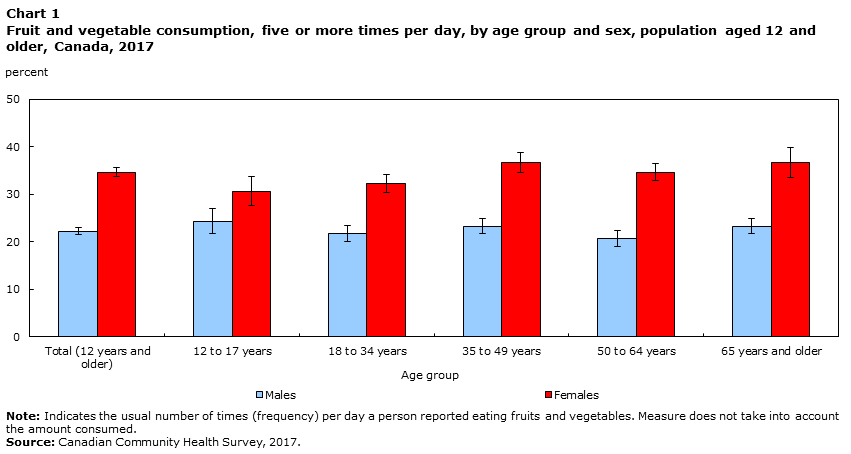Health Fact Sheets
Fruit and vegetable consumption, 2017
Archived Content
Information identified as archived is provided for reference, research or recordkeeping purposes. It is not subject to the Government of Canada Web Standards and has not been altered or updated since it was archived. Please "contact us" to request a format other than those available.
Fruit and vegetable consumption provides an important source of vitamins, minerals and fiber, which may reduce the risk of heart disease and some types of cancer.Note
In 2017, 28.6% of Canadians aged 12 and older (roughly 8.3 million people) reported that they had consumed fruits and vegetables five or more times per day.Note Note Note Since 2015, the proportion of Canadians reporting that they have consumed fruits and vegetables five or more times per day has been decreasing (31.5% in 2015 and 30.0% in 2016).Note
Females were more likely than males to report consuming fruits and vegetables five or more times per day (34.7%, 22.3%). The proportion of females aged 12 and older who reported that they had consumed fruits and vegetables five or more times per day declined between 2016 and 2017 (36.9%, 34.7%), while the proportion for males remained stable.
In 2017, consumption of fruit and vegetables among females was lower among 12 to 17 year olds (30.7%) compared to those aged 35 and older (Chart 1). Conversely for males, most age groups were similar in reported fruit and vegetable consumption.

Data table for Chart 1
| Age group | Percent | Confidence Interval | |
|---|---|---|---|
| Lower 95% | Upper 95% | ||
| Males | |||
| Total (12 years and older) | 22.3 | 21.5 | 23.1 |
| 12 to 17 years | 24.4 | 21.8 | 27.0 |
| 18 to 34 years | 21.8 | 20.1 | 23.5 |
| 35 to 49 years | 23.3 | 21.7 | 24.9 |
| 50 to 64 years | 20.7 | 19.0 | 22.4 |
| 65 years and older | 23.3 | 21.7 | 24.9 |
| Females | |||
| Total (12 years and older) | 34.7 | 33.7 | 35.6 |
| 12 to 17 years | 30.7 | 27.7 | 33.7 |
| 18 to 34 years | 32.4 | 30.5 | 34.3 |
| 35 to 49 years | 36.7 | 34.7 | 38.8 |
| 50 to 64 years | 34.7 | 32.8 | 36.5 |
| 65 years and older | 36.7 | 35.1 | 38.3 |
|
Note: Indicates the usual number of times (frequency) per day a person reported eating fruits and vegetables. Measure does not take into account the amount consumed. Source: Canadian Community Health Survey, 2017. |
|||
Comparisons by province indicated that Quebec had the highest proportion of residents who reported eating fruits and vegetables at least five times daily (34.5%). Less than 1 in 5 (18.3%) respondents in Newfoundland and Labrador reported consuming fruits and vegetables five times a day.
In 2017, Canadians who reported living in food secure households were more likely to report consuming fruit and vegetables five or more times per day (29.5%) than those in moderately or severely food insecure households (21.2%, 19.3%).Note
Research has shown that increased sedentary time is associated with unhealthy dietary behaviours.Note The proportion of Canadians reporting they consumed fruits and vegetables five or more times per day decreased as the reported amount of screen timeNote increased. Canadians aged 12 and over were more likely to report consuming fruit and vegetables five or more times per day when they reported less than four hours of screen time per day (31.6%) than if they reported six hours or more (17.7%).
For analysis of fruit and vegetable consumption with other healthy behaviours see the ‘Healthy Behaviours’ Fact Sheet.
References
Agudo, A. 2005. Measuring intake of fruit and vegetables. Background Paper for the Joint FAO/WHO Workshop on Fruit and Vegetables for Health, 2004, Kobe, Japan. WHO, Electronic Resource. (accessed August 17, 2018).
Garriguet, D. 2007. Canadians’ eating habits. Health Reports. Statistics Canada Catalogue no. 82-003. Vol. 18, no. 2. (accessed July 4, 2018).
Kirkpatrick, S.I. and V. Tarasuk. 2008. Food insecurity is associated with nutrient inadequacies among Canadian adults and adolescents. Journal of Nutrition. 138(3): 604-12. (accessed August 17, 2018).
Pearson, N. and S.J.H. Biddle. 2011. Sedentary behaviour and dietary intake in children, adolescents and adults: A systematic review. American Journal of Preventive Medicine, 41(2), 178 –188. (accessed August 17, 2018).
Pérez, C.E. 2002. Fruit and vegetable consumption. Health Reports. Statistics Canada Catalogue no. 82-003. Vol. 13, no. 3. (accessed July 4, 2018).
Roark, R.A. and V.P. Niederhauser. 2013. Fruit and vegetable intake: issues with definition and measurement. Public Health Nutrition, 16, 2–7. (accessed August 17, 2018).
Slavin, J.L. and B. Lloyd. 2012. Health Benefits of Fruits and Vegetables. Advances in Nutrition, 3(4), 506–516. (accessed August 17, 2018).
Data
Additional data from the Canadian Community Health Survey are available from table 13-10-0096-01.
- Date modified:

